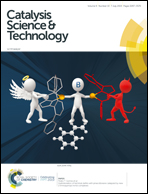Bimetallic Ni–Co composites anchored on a wool ball-like carbon framework as high-efficiency bifunctional electrodes for rechargeable Zn–air batteries†
Abstract
Two-dimensional (2D) graphene nanosheets and one-dimensional (1D) carbon nanotubes were constructed into loosened wool ball-like carbons (NiCo@N–Cs) by a hydrothermal treatment and pyrolysis. The built graphene/nanotube networks show highly accessible 3D open aisles and peculiar microstructures, which not only facilitated mass and electron transport but also increased the active site density. In alkaline solution, the prepared NiCo@N–C-900 exhibits a positive half-wave potential (E1/2) of 0.88 V for the oxygen reduction reaction and a low overpotential (Eη) of 0.28 V at a current density of 10 mA cm−2 for the oxygen evolution reaction, superior to the benchmark Pt/C (E1/2 = 0.84 V) and IrO2 (Eη = 0.32 V) catalysts as well as the best Ni–Co electrocatalysts reported in the literature (E1/2 = 0.87 V, Eη = 0.31 V). In acidic solution, the activity of the ORR on NiCo@N–C-900 is comparative to that on Pt/C and significantly higher than that of all reported Ni–Co electrocatalysts. The primary zinc–air batteries using NiCo@N–C-900 as the advanced air electrode exhibited higher open-circuit potentials (OCPs), peak power density and rechargeability than the Pt/C-based counterpart. This work provides an effective strategy to prepare high-performance bifunctional electrocatalysts in sustainable energy conversion systems.



 Please wait while we load your content...
Please wait while we load your content...